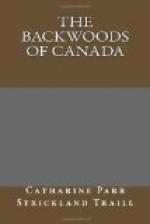The shanty is a sort of primitive hut in Canadian architecture, and is nothing more than a shed built of logs, the chinks between the round edges of the timbers being filled with mud, moss, and bits of wood; the roof is frequently composed of logs split and hollowed with the axe, and placed side by side, so that the edges rest on each other; the concave and convex surfaces being alternately uppermost, every other log forms a channel to carry off the rain and melting snow. The eaves of this building resemble the scolloped edges of a clamp shell; but rude as this covering is, it effectually answers the purpose of keeping the interior dry; far more so than the roofs formed of bark or boards, through which the rain will find entrance. Sometimes the shanty has a window, sometimes only an open doorway, which admits the light and lets out the smoke*. A rude chimney, which is often nothing better than an opening cut in one of the top logs above the hearth, a few boards fastened in a square form, serves as the vent for the smoke; the only precaution against the fire catching the log walls behind the hearth being a few large stones placed in a half circular form, or more commonly a bank of dry earth raised against the wall.
[* I was greatly amused by the remark made by a little Irish boy, that we hired to be our hewer of wood and drawer of water, who had been an inhabitant of one of these shanties. “Ma’am” said he, “when the weather was stinging cold, we did not know how to keep ourselves warm; for while we roasted our eyes out before the fire our backs were just freezing; so first we turned one side and then the other, just as you would roast a guse on a spit. Mother spent half the money father earned at his straw work (he was a straw chair maker,) in whiskey to keep us warm; but I do think a larger mess of good hot praters (potatoes,) would have kept us warmer than the whiskey did.”]
Nothing can be more comfortless than some of these shanties, reeking with smoke and dirt, the common receptacle for children, pigs, and fowls. But I have given you the dark side of the picture; I am happy to say all the shanties on the squatters’ ground were not like these: on the contrary, by far the larger proportion were inhabited by tidy folks, and had one, or even two small windows, and a clay chimney regularly built up through the roof; some were even roughly floored, and possessed similar comforts with the small log-houses.
[Illustration: Log house]
You will, perhaps, think it strange when I assure you that many respectable settlers, with their wives and families, persons delicately nurtured, and accustomed to every comfort before they came hither, have been contented to inhabit a hut of this kind during the first or second year of their settlement in the woods.
I have listened with feelings of great interest to the history of the hardships endured by some of the first settlers in the neighbourhood, when Peterborough contained but two dwelling houses. Then there were neither roads cut nor boats built for communicating with the distant and settled parts of the district; consequently the difficulties of procuring supplies of provisions was very great, beyond what any one that has lately come hither can form any notion of.




